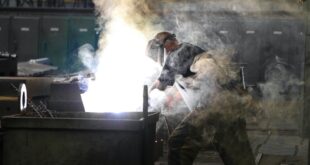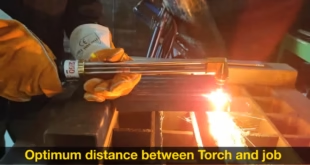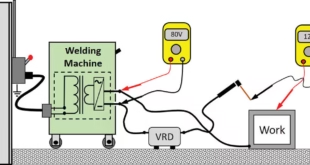Fire and Heat Safety In Welding
Introduction
Fire and heat safety play a critical role in welding operations. Welding processes involve the application of intense heat, sparks, and molten metal, creating a high risk of fire hazards. Ignoring proper safety precautions can lead to severe consequences, including fires, injuries, and even fatalities. Therefore, it is essential for welders and employers to understand the importance of fire and heat safety and implement necessary measures to mitigate risks.
Welding processes generate significant amounts of heat, which can easily ignite flammable materials in the vicinity. Sparks produced during welding can travel several feet, posing a serious risk of igniting combustible substances. Additionally, the presence of flammable gases, such as acetylene and propane, further increases the potential for fire accidents. The use of electrical equipment and power sources also introduces electrical fire hazards if not handled correctly.
The purpose of this article is to provide essential guidelines for maintaining fire and heat safety in welding operations. By following these guidelines, welders can minimize the risks associated with welding processes and create a safer working environment. The article will cover preventive measures for fire and heat safety, the importance of personal protective equipment (PPE), and emergency preparedness and response. Implementing these guidelines will not only protect the lives and well-being of welders but also safeguard the surrounding property and equipment.
Understanding Fire Hazards in Welding
Welding processes involve the generation of intense heat and sparks, making it important to be aware of the fire hazards associated with such operations.
How welding processes generate heat and sparks?
During welding, heat is generated by the electrical current passing through the welding equipment and workpiece. This heat melts the metal, allowing it to fuse together. The welding arc itself can reach temperatures as high as 6,000 degrees Fahrenheit, producing sparks and intense radiant heat.
Potential ignition sources in welding operations
Welding operations present various potential ignition sources that can lead to fires if not properly managed. Some common ignition sources include:
- Sparks: Sparks are produced when the welding electrode or filler material comes into contact with the workpiece. These sparks can travel significant distances and ignite nearby flammable materials.
- Hot workpieces: The molten metal and heated workpieces can remain hot for some time after welding, posing a risk of igniting nearby materials.
- Hot slag: Slag is a byproduct of the welding process and can remain hot for an extended period. If it comes into contact with flammable materials, it can cause a fire.
- Welding equipment: Electrical equipment used in welding, such as power sources and cables, can generate heat and potentially cause electrical fires if not properly maintained or insulated.

Common Fire Hazards
- Flammable materials: Welding near flammable materials, such as wood, paper, or chemicals, increases the risk of fire. Sparks or radiant heat can ignite these materials, leading to rapid fire spread. Proper storage and separation of flammable substances are essential to minimize the risk.
- Combustible gases: Some welding processes utilize combustible gases like acetylene or propane. These gases are highly flammable and can create hazardous conditions if not handled and stored properly. Any leakage or mishandling of these gases can result in fires or explosions.
- Electrical equipment: Welding equipment relies on electrical power sources, which can be a fire hazard if not appropriately maintained. Damaged cables, faulty wiring, or inadequate grounding can lead to electrical fires. Regular inspections and maintenance of electrical equipment are vital to prevent such hazards.
These fire hazards associated with welding is crucial for implementing effective fire prevention measures. By identifying potential ignition sources and addressing common fire hazards, welders can significantly reduce the risk of fires and create a safer working environment.
Preventive Measures for Fire and Heat Safety
Proper Ventilation and Air Quality Control
- Proper ventilation is crucial in welding areas to ensure the removal of hazardous fumes, gases, and airborne particles generated during the welding process. Inadequate ventilation can lead to the accumulation of toxic substances, compromising air quality and increasing the risk of respiratory issues for welders.
- To maintain adequate ventilation, welding areas should have a well-designed system that efficiently removes fumes and gases. This can be achieved through the use of exhaust hoods, local exhaust ventilation (LEV) systems, and ventilation fans. Ensuring proper placement and functioning of these systems helps control the dispersion of hazardous contaminants.
Safe Handling and Storage of Flammable Materials
- Flammable materials should be stored in designated areas away from welding operations. These storage areas should be well-ventilated, fire-resistant, and equipped with proper safety measures, such as fire-resistant cabinets or containers. Segregating flammable materials from ignition sources minimizes the risk of fire accidents.
- When handling flammable materials, it is important to follow safe practices, such as using appropriate containers and tools. Any flammable waste, such as rags or debris, should be properly stored and disposed of in designated containers to prevent accidental ignition.
Electrical Safety Precautions
- Welding involves the use of electrical equipment, which presents electrical hazards if not handled with caution. It is crucial to understand the risks associated with electrical shocks, burns, and short circuits. Following proper lockout/tagout procedures, inspecting equipment for damage, and using grounded electrical connections can prevent electrical accidents.
- Grounding welding equipment is vital to prevent electric shock hazards. Proper grounding ensures that any electrical faults are directed away from the welder. Insulation of cables and electrical components also helps protect against electrical fires and shocks.
Fire Extinguishers and Fire Suppression Systems:
Types of fire extinguishers suitable for welding areas
Different types of fire extinguishers, such as Class A, B, or C extinguishers, may be suitable for welding areas depending on the potential fire risks. Understanding the appropriate use and limitations of each extinguisher type is essential for effective fire suppression.
Installation and maintenance of fire suppression systems
Installing fire suppression systems, such as sprinklers or automatic fire detection systems, can provide an added layer of protection. Regular inspections and maintenance of these systems ensure their proper functioning in case of a fire emergency.
By implementing these preventive measures, welders can significantly reduce the risk of fire and heat-related incidents in welding operations. It is essential to prioritize fire and heat safety to safeguard the well-being of personnel and maintain a secure working environment.
Personal Protective Equipment (PPE) for Fire and Heat Safety
Welding Helmets and Face Shields
Eye protection and selecting the right helmet
Eye protection is crucial in welding operations due to the intense brightness of the welding arc and the risk of flying sparks or debris. Welding helmets with appropriate shading levels protect the eyes from harmful ultraviolet (UV) and infrared (IR) radiation. Selecting the right helmet based on the welding process and the required shade level ensures optimal eye safety.
How to Choose Right Face Shield
Face shields provide additional protection to the face and neck areas against sparks, hot slag, and splatter. When choosing face shields, it is important to consider features such as impact resistance, optical clarity, and the ability to cover a sufficient area to protect the entire face.
Fire-Resistant Clothing
Role of flame-resistant clothing in protecting against heat and sparks
Flame-resistant clothing is essential for welders as it provides protection against heat, sparks, and molten metal splatter. It reduces the risk of burns and minimizes the severity of injuries in case of accidental contact with hot surfaces or flying debris. Flame-resistant clothing acts as a barrier, preventing ignition and reducing the potential for burn injuries.
Types of fire-resistant materials and their properties
Fire-resistant clothing is typically made from materials such as treated cotton, flame-resistant (FR) cotton, or specialized fabrics like Nomex® or Kevlar®. These materials have inherent fire-resistant properties and are designed to withstand high temperatures, providing a layer of protection against heat and sparks.
Hand and Foot Protection
Selection and proper use of welding gloves
Welding gloves are crucial for protecting the hands and wrists from burns, sparks, and molten metal. When selecting welding gloves, it is important to choose ones made from heat-resistant materials like leather or a combination of leather and fire-resistant fabrics. Proper glove fit, dexterity, and ensuring they are in good condition are essential for effective hand protection.
Choosing appropriate footwear for welding operations
Welding operations require footwear that offers protection against sparks, hot metal, and potential electrical hazards. Steel-toed boots or shoes made from heat-resistant materials are recommended. Slip-resistant soles provide better traction in the work area, reducing the risk of slips and falls.
By wearing appropriate PPE, including welding helmets, face shields, flame-resistant clothing, gloves, and suitable footwear, welders can significantly reduce the risk of fire and heat-related injuries. PPE acts as a crucial barrier between the welder’s body and potential hazards, ensuring their safety and well-being during welding operations.
Emergency Preparedness and Response
Training and Education:
Importance of providing comprehensive training to welding personnel
Comprehensive training is essential to ensure that welding personnel are well-informed about fire and heat safety protocols. Training should cover the identification of fire hazards, safe operating procedures, proper handling of equipment, and the correct use of PPE. By providing thorough training, welders are better equipped to prevent and respond to fire and heat-related emergencies.
Topics to cover in fire and heat safety training programs
Fire and heat safety training programs should cover a range of topics, including:
- Recognition and prevention of fire hazards in welding operations.
- Proper use and maintenance of firefighting equipment, such as fire extinguishers.
- Procedures for reporting fire incidents and emergency contact information.
- Fire evacuation procedures, including designated assembly points.
- Handling emergency situations involving burns or injuries.
- Safe shutdown procedures for welding equipment in case of emergencies.
Emergency Response Plan:
Effective emergency plan
An emergency response plan specific to welding operations should be developed and communicated to all personnel. The plan should outline clear steps to be followed in the event of a fire or heat-related emergency. It should include designated roles and responsibilities, evacuation routes, and procedures for contacting emergency services. Regular drills and exercises can help ensure that personnel are familiar with the emergency plan.
Communication protocols and evacuation procedures
Effective communication is vital during emergencies. Welding operations should establish clear communication protocols to alert personnel about fire incidents, initiate evacuations, and provide updates on the situation. This can include alarm systems, visual signals, or designated personnel responsible for sounding the alarm. Evacuation procedures should be well-defined, indicating primary and alternative evacuation routes, assembly points, and procedures for accounting for all personnel.
By prioritizing training and education on fire and heat safety and developing a comprehensive emergency response plan, welding operations can minimize the potential impact of fire incidents. It is crucial to ensure that all personnel are well-prepared to respond promptly and effectively during emergencies, reducing the risk of injuries, property damage, and loss of life.
FAQs
What are fire precautions for welding?
Fire precautions for welding include ensuring proper ventilation, using fire-resistant materials, keeping flammable materials away from the welding area, having fire extinguishers readily available, and implementing an emergency response plan.
What is fire in welding?
Fire in welding refers to the potential ignition and combustion of materials during welding operations. It can result from sparks, hot slag, or heat generated by the welding process coming into contact with flammable materials.
What are the fire related risks of welding?
The fire-related risks of welding include the ignition of flammable materials, such as gases, liquids, or solids, and the potential for fire spread. Sparks, hot slag, and radiant heat can cause fires, and welding equipment or electrical faults can lead to electrical fires.
What are 3 safety rules for welding?
Three safety rules for welding are:
a) Always wear appropriate PPE, including welding helmets, gloves, and fire-resistant clothing.
b) Ensure proper ventilation in the welding area to remove fumes and gases.
c) Follow safe operating procedures, including proper equipment setup, secure grounding, and avoiding the presence of flammable materials.
What is heating in welding?
Heating in welding refers to the process of generating and applying heat to melt the workpieces and create a fusion. This heat is typically generated through an electric arc or a flame produced by a welding torch.
What temperature is fire welding?
The temperature of a welding flame can vary depending on the welding process and the type of fuel used. Generally, temperatures can range from around 3,500 to 6,500 degrees Fahrenheit (1,900 to 3,600 degrees Celsius).
What are 3 fire precautions?
Three fire precautions include:
a) Regularly inspecting and maintaining fire extinguishers to ensure they are in proper working condition.
b) Identifying and eliminating potential ignition sources, such as open flames or electrical hazards.
c) Having a fire safety plan in place, including clear evacuation procedures and designated assembly points.
What is welding safety?
Welding safety encompasses the practices and precautions taken to ensure the well-being of personnel during welding operations. This includes using appropriate personal protective equipment, implementing fire and heat safety measures, following safe operating procedures, and being prepared for emergencies.
Which fire extinguisher for welding?
The choice of fire extinguisher for welding depends on the type of fire risks present. Class B and Class C fire extinguishers are commonly used for welding operations, as they are effective against flammable liquids and electrical fires. It is important to select the right type of fire extinguisher and ensure it is suitable for the specific fire hazards involved in welding.
Conclusion
In conclusion, fire and heat safety in welding operations is of utmost importance. Throughout this article, we have discussed various key points that highlight the significance of adhering to fire and heat safety guidelines in welding. We began by understanding the risks and hazards associated with welding processes, including the generation of intense heat, sparks, and the presence of flammable materials and gases. We then explored preventive measures such as proper ventilation, safe handling and storage of flammable materials, electrical safety precautions, and the importance of fire extinguishers and fire suppression systems.
Furthermore, we delved into the significance of personal protective equipment (PPE) in welding, including welding helmets, face shields, fire-resistant clothing, and appropriate hand and foot protection. These PPE items provide essential protection against heat, sparks, and potential injuries.We also highlighted the importance of training and education, emphasizing the need for comprehensive fire and heat safety training programs for welding personnel. By providing adequate training, personnel can understand and implement proper safety protocols, minimizing the risk of fire incidents and injuries.
Additionally, we discussed the importance of developing and implementing an effective emergency response plan, including clear communication protocols and evacuation procedures. Being prepared for emergencies ensures a swift and organized response, safeguarding the lives and well-being of personnel.
 Welding of Welders All about Welding and Welders
Welding of Welders All about Welding and Welders



